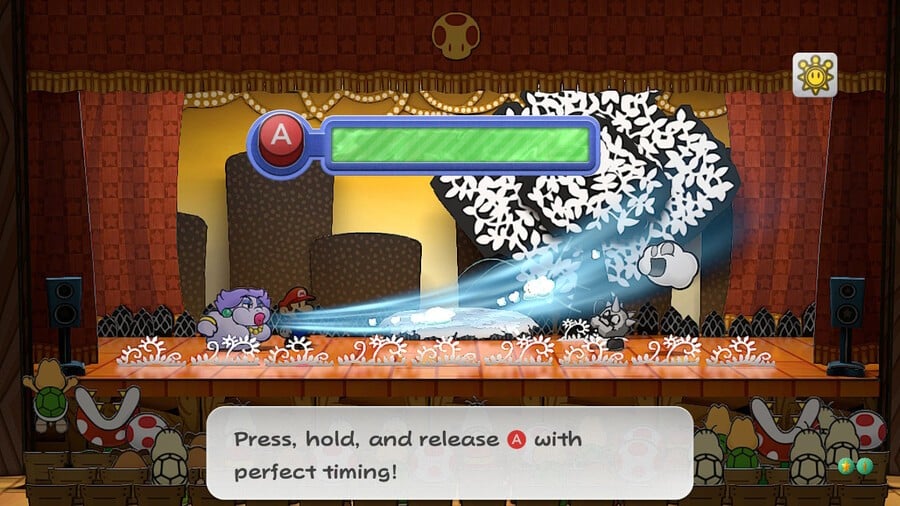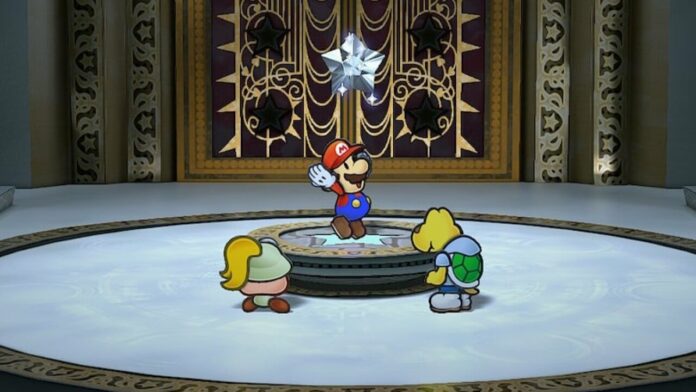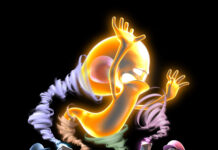It’s been nearly 20 years since we first set foot on the cobbled streets of Rogueport, the hub town of GameCube favourite Paper Mario: The Thousand-Year Door. Back in 2004, the seedy streets of the criminal town felt like nothing else in a Mario game – suspicious characters roam the streets, puddles pool on the pavement, and cracked windows add a slice of decoration. To those who have played Thousand-Year Door, Rogueport became a character in its own right and served as a platform for an exciting adventure.
20 years later, we felt exactly the same stepping into Rogueport in the Switch version of Paper Mario: The Thousand-Year Door. This place still feels entirely unique not just in Paper Mario canon, but in all of Mario adventures. That sense of unease, excitement, and wonder sets the stage for Mario’s most beloved RPG adventure. We’ve played through the prologue and the first three chapters of the Switch version, and it’s been a joy revisiting this classic.
Let’s talk about just what Paper Mario: The Thousand-Year Door on Switch is. While it’s being marketed as a remake, it certainly sits between both this and a ‘remaster’. This is, by and large, a hugely faithful recreation of the 2004 paper-crafted adventure. Dialogue is largely the same, save for one or two instances of tweaking the text to better match the Japanese original, and the visuals have received a significant update, but from what we can tell, this is the very same adventure we went on in 2004. That’s absolutely not a bad thing – Thousand-Year Door has its reputation of being the best Paper Mario game for a reason, and so far, this revisit has us nodding our heads in agreement with that statement all over again.
Focusing on the visuals, Thousand-Year Door has received a huge glow-up. The arts and crafts paper aesthetic from the GameCube version is all intact, but the Switch version adds tons more detail to environments. The cobblestones of Rogueport are much more defined, meaning the dirty puddles of water are more visible. Little flecks of green in combat backgrounds now have trees or bushes dotted around them, and the foliage of the trees is more defined and colourful. Overall, the Switch version also uses brighter colours and is less washed-out than the GameCube version. Don’t worry, Rogueport still feels like the dingy, seedy town that it is, but the bursts of colour throughout the game really enhance the storybook style that all the Paper Mario games are going for.
This is helped doubly by the improved lighting throughout the game. Wandering through Hooktail Castle, the first major dungeon of Thousand-Year Door, the soft bloom of the light glowing through the broken windows really helped enhance the decrepit, menacing feel of the castle. It also made the dungeon look darker and helped those darker shades of grey pop. We can say the same about Boggly Woods, a beautiful, eerie forest with white foliage and multicoloured flooring. The way the light cracks through the trees makes the floor almost glow, and it makes you feel like you’re walking across a sparkly, leafy rainbow. It’s lovely, and looks amazing both on the TV and undocked on the OLED.
The game runs perfectly in both formats too, at least from the 15 or so hours we’ve played. We’ve not noticed a single frame drop both docked and undocked. However, one downgrade from the GameCube version is that the Switch version only runs at 30fps, compared to the GameCube’s native 60fps. At first, this took us a moment to adjust to, particularly in combat where you have to time button-presses – our brains somehow remember the timing of the original release – but overall the reduced frame rate hasn’t been detrimental to the experience for us. This is still Thousand-Year Door in all its glory — at least from what we’ve played.

That goes right down to the combat, which is similar to Super Mario RPG’s turn-based action-command system and an evolution of the original Paper Mario’s combat. Mario and one other ‘partner’ can take part in battle, and you have multiple options, such as attacking by Jumping or using the Hammer (for Mario), magical Special moves that range from healing your party to freezing all enemies for a few turns, and appealing to the crowd. That last one is important, as every single battle takes place on a theatre stage, so timing your attacks, appealing to the crowd, and even accepting gifts and ejecting audience members all play into your battle strategies. The bigger your crowd and more successful your timing, the more Star Power (used for Special Moves) is accrued. Presentation-wise, it’s such a fun idea, but the fact the audience plays such a huge part in the mechanics is delightful.
A few new features have been added to the Switch version of Thousand-Year Door to help ease new players into the experience – these are particularly helpful if you’ve never played a Paper Mario game before. A new NPC called the Battle Master hangs out in Rogueport and helps teach you how to master action commands in battle. Tapping ‘ZL’ anywhere in the field will prompt one of your companions to give you a hint on what to do next. The Trouble Center – home to the game’s side quests – returns, but if you’re struggling, you can pay an NPC to give you hints on how to proceed. Plus, these hints will be logged in your Journal, which can be found in the menu. Merluvlee, a fortune teller who gives you hints on where to track down the game’s collectibles, isn’t a new NPC, but her hints are now logged in your Journal, too.
One thing to note, however, is that there aren’t any difficulty modes, but from what we can remember, the game’s tuning feels about the same as it did on GameCube, meaning it’s not significantly easier á la Super Mario RPG. Small conveniences are the name of the game here. But two pretty considerable additions make the game a little less frictional.
First up is the Partner Wheel, which allows you to instantly swap between partners outside of battle at the touch of a button. This is extremely useful and saves a lot of flipping through menus, as each partner has a field skill that you’ll need to navigate the world. Koops, the anxious and shy Koopa who wants to save his father, can grab items from afar by getting inside his shell and being launched forward; and Madame Flurrie can blow away enemies or reveal hidden paths by blowing big gusts of wind in front of her.
The puzzle element of exploration in Thousand-Year Door (and the original Paper Mario) is intact here, and more fun than ever thanks to the Partner Wheel. But Mario also gets some additional skills as you adventure through the world. Early on, Mario gets ‘cursed’ by a strange black treasure chest, which allows him to turn into a paper aeroplane and fly across large gaps. Later on, he can also flip to allow him to shimmy through thin gaps. Gaining these new skills gradually encourages exploration and backtracking, and makes discovering the world of Thousand-Year Door delightful.
Speaking of backtracking, this is arguably the biggest weakness of the original GameCube game. That’s still the case in story chapters (looking at Chapter 2 in particular), but you’ll gain access to a Warp Pipe room which allows you to fast-travel back to the other towns. Yes, this existed in the GameCube version, but it’s been tweaked heavily for the Switch release – no longer do you need to break huge blocks to access pipes, nor do you need to remember which pipe goes where. Each blue pipe is labelled with a number corresponding to the chapter you visited that town in, meaning you can easily get back to Petalburg or the Great Tree by simply following the numbers. It might take a minute to unlock, but it makes those Trouble Center requests much easier to complete. And you can access it straight from Rogueport rather than going through the Sewers each time.
There’s plenty more hiding in the pages of Paper Mario: The Thousand-Year Door on Switch — and we’ll save them for our final verdict — but the first few chapters of the game have reminded us of why we loved the original back in 2004. It’s just as funny as we remember, with excellent writing and an actually interesting story that goes beyond Mario series tropes – often making fun of them. Peach and Bowser still have their own playable sections, with the former teaching a definitely not-HAL from 2001: A Space Odyssey about the concept of love, while the latter tries to save Princess Peach because he’s the only one who’s allowed to kidnap her.
Thousand-Year Door is stupid, fun, and sometimes even a little bit heartbreaking — there’s even a tournament arc, for goodness sake — and we can’t wait to rediscover the rest of this RPG.
www.nintendolife.com







